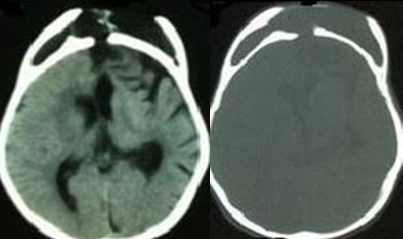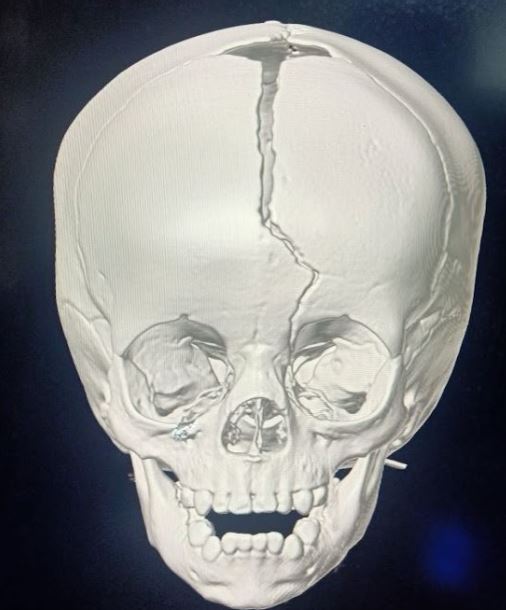[1]
Bir SC,Kalakoti P,Notarianni C,Nanda A, John Howship (1781-1841) and growing skull fracture: historical perspective. Journal of neurosurgery. Pediatrics. 2015 Oct
[PubMed PMID: 26186359]
Level 3 (low-level) evidence
[2]
Kumar A,Jaiswal G,Kankane VK,Kumar PK,Gupta TK, Arrested Hydrocephalus Complicated by Growing Skull Fracture - A Case Report with Review of Literature. Journal of pediatric neurosciences. 2020 Jul-Sep
[PubMed PMID: 33531942]
Level 3 (low-level) evidence
[3]
Choi JI,Kim SD, Pediatric Minor Traumatic Brain Injury : Growing Skull Fracture, Traumatic Cerebrospinal Fluid Leakage, Concussion. Journal of Korean Neurosurgical Society. 2022 May
[PubMed PMID: 35468709]
[4]
Britz GW,Kim DK,Mayberg MR, Traumatic leptomeningeal cyst in an adult: a case report and review of the literature. Surgical neurology. 1998 Nov;
[PubMed PMID: 9842874]
Level 3 (low-level) evidence
[5]
Mendpara V,Sahu S,Madhu K,Tarannum Shaik S,Maram MR,Natarajan B,Movva S,Sayed Mushir Ali A,Chauhan DR, Cranioplasty for a Growing Fracture of the Skull: A Case Report. Cureus. 2022 Oct
[PubMed PMID: 36381935]
Level 3 (low-level) evidence
[6]
Zemann W,Metzler P,Jacobsen C,Kruse AL,Lübbers HT,Könü D,Obwegeser JA, Growing skull fractures after craniosynostosis repair: risk factors and treatment algorithm. The Journal of craniofacial surgery. 2012 Sep;
[PubMed PMID: 22948644]
[7]
Abuzayed B,Tuzgen S,Canbaz B,Yuksel O,Tutunculer B,Sanus GZ, Reconstruction of growing skull fracture with in situ galeal graft duraplasty and porous polyethylene sheet. The Journal of craniofacial surgery. 2009 Jul;
[PubMed PMID: 19553832]
[8]
Aryan HE,Meltzer HS,Gerras GG,Jandial R,Levy ML, Leptomeningeal cyst development after endoscopic craniosynostosis repair: case report. Neurosurgery. 2004 Jul;
[PubMed PMID: 15214995]
Level 3 (low-level) evidence
[9]
Djientcheu VD,Rilliet B,Delavelle J,Argyropoulo M,Gudinchet F,de Tribolet N, Leptomeningeal cyst in newborns due to vacuum extraction: report of two cases. Child's nervous system : ChNS : official journal of the International Society for Pediatric Neurosurgery. 1996 Jul;
[PubMed PMID: 8869777]
Level 3 (low-level) evidence
[10]
Curtis J,King SJ,Weindling AM, Case report: Leptomeningeal cyst: an unusual complication of delivery by vacuum extraction. Clinical radiology. 1998 Nov;
[PubMed PMID: 9833794]
Level 3 (low-level) evidence
[11]
Kozaki Y,Nonaka M,Miki K,Tanaka H,Abe H,Inoue T, Endoscopic-assisted Duraplasty with Collagen Matrix for Growing Skull Fracture: A Case Report. NMC case report journal. 2021
[PubMed PMID: 35079464]
Level 3 (low-level) evidence
[12]
Vezina N,Al-Halabi B,Shash H,Dudley RR,Gilardino MS, A Review of Techniques Used in the Management of Growing Skull Fractures. The Journal of craniofacial surgery. 2017 May;
[PubMed PMID: 28060103]
[14]
Bava J,Bansal A,Patil SB,Kale KA,Joshi AR, Posttraumatic Intradiploic Leptomeningeal Cyst: A Rare Complication of Head Trauma. Case reports in radiology. 2015;
[PubMed PMID: 26558129]
Level 3 (low-level) evidence
[15]
Singh I,Rohilla S,Siddiqui SA,Kumar P, Growing skull fractures: guidelines for early diagnosis and surgical management. Child
[PubMed PMID: 27023392]
[16]
Jain S,Gandhi A,Sharma A,Mittal RS, Growing skull fracture with cerebrospinal fluid fistula: A rare case report and its management strategies. Asian journal of neurosurgery. 2015 Jul-Sep;
[PubMed PMID: 26396614]
Level 3 (low-level) evidence
[17]
Kim I, Growing Skull Fracture in the Primary Motor Cortex in a 50-day-old Child: A Case Report. Korean journal of neurotrauma. 2020 Oct
[PubMed PMID: 33163438]
Level 3 (low-level) evidence
[18]
Prasad GL,Gupta DK,Mahapatra AK,Borkar SA,Sharma BS, Surgical results of growing skull fractures in children: a single centre study of 43 cases. Child's nervous system : ChNS : official journal of the International Society for Pediatric Neurosurgery. 2015 Feb
[PubMed PMID: 25227164]
Level 3 (low-level) evidence
[19]
Singhal GD,Atri S,Suggala S,Jaluka D,Singhal S,Shrivastava AK, Growing Skull Fractures; Pathogenesis and Surgical Outcome. Asian journal of neurosurgery. 2021 Jul-Sep
[PubMed PMID: 34660366]
[20]
Sim SY,Kim HG,Yoon SH,Choi JW,Cho SM,Choi MS, Reappraisal of Pediatric Diastatic Skull Fractures in the 3-Dimensional CT Era: Clinical Characteristics and Comparison of Diagnostic Accuracy of Simple Skull X-Ray, 2-Dimensional CT, and 3-Dimensional CT. World neurosurgery. 2017 Dec;
[PubMed PMID: 28844920]
[21]
Voet D,Govaert P,Caemaert J,de Lille L,D'herde K,Afschrift M, Leptomeningeal cyst: early diagnosis by color Doppler imaging. Pediatric radiology. 1992;
[PubMed PMID: 1437364]
[22]
Naim-Ur-Rahman,Jamjoom Z,Jamjoom A,Murshid WR, Growing skull fractures: classification and management. British journal of neurosurgery. 1994
[PubMed PMID: 7718163]
[23]
Kim H,Jo KW, Treatment of a traumatic leptomeningeal cyst in an adult with fibrinogen-based collagen. Journal of Korean Neurosurgical Society. 2013 May;
[PubMed PMID: 23908705]
[24]
Kashiwagi S,Abiko S,Aoki H, Growing skull fracture in childhood. A recurrent case treated by shunt operation. Surgical neurology. 1986 Jul;
[PubMed PMID: 3715702]
Level 3 (low-level) evidence
[25]
Tamada I,Ihara S,Hasegawa Y,Aoki M, Surgical Treatment of Growing Skull Fracture: Technical Aspects of Cranial Bone Reconstruction. The Journal of craniofacial surgery. 2019 Jan
[PubMed PMID: 30444774]
[26]
Singh V,Sasidharan GM,Bhat DI,Devi BI, Growing Skull Fracture and the Orbitocranial Variant: Nuances of Surgical Management. Pediatric neurosurgery. 2017
[PubMed PMID: 28427053]
[27]
Chen X,Dai H, Intradiploic encephalocele following linear skull fracture: a rare evolution of growing skull fracture. Child's nervous system : ChNS : official journal of the International Society for Pediatric Neurosurgery. 2021 Dec
[PubMed PMID: 33715079]
[28]
Tewfik K,Covelli C,Rossini M,Burlini D, Lump on the scalp of a child arising over a previous parietal fracture: growing skull fracture or post-traumatic lipoma? BMJ case reports. 2022 Apr 4
[PubMed PMID: 35379677]
Level 3 (low-level) evidence
[30]
Diebler C,Dulac O, Cephaloceles: clinical and neuroradiological appearance. Associated cerebral malformations. Neuroradiology. 1983;
[PubMed PMID: 6633855]
[31]
Naidich TP,Altman NR,Braffman BH,McLone DG,Zimmerman RA, Cephaloceles and related malformations. AJNR. American journal of neuroradiology. 1992 Mar-Apr;
[PubMed PMID: 1566723]
[32]
Yokota A,Kajiwara H,Kohchi M,Fuwa I,Wada H, Parietal cephalocele: clinical importance of its atretic form and associated malformations. Journal of neurosurgery. 1988 Oct;
[PubMed PMID: 3418387]
[33]
Lopez J,Chen J,Purvis T,Reategui A,Khavanin N,Iyer R,Manson PN,Dorafshar AH,Cohen AR,Redett RJ, Pediatric Skull Fracture Characteristics Associated with the Development of Leptomeningeal Cysts in Young Children after Trauma: A Single Institution
[PubMed PMID: 32332544]
[34]
San Martín-García I,Aguilera-Albesa S,Zazpe-Cenoz I,Yoldi-Petri ME, [Recurring post-traumatic growing skull fracture]. Revista de neurologia. 2015 Apr 16
[PubMed PMID: 25857859]
[35]
Kulkarni AV,Dikshit P,Devi BI,Sadashiva N,Shukla D,Bhat DI, Unusual Complication of a Neglected Growing Skull Fracture. Pediatric neurosurgery. 2021
[PubMed PMID: 33626526]
[36]
Baldawa S, Remote intracranial hemorrhage following surgery for giant orbitofrontal growing skull fracture: A lesson learnt. Journal of pediatric neurosciences. 2016 Apr-Jun
[PubMed PMID: 27606019]

